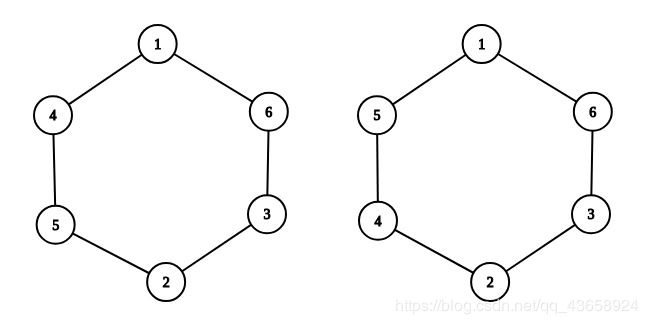- Codeforces Round 972 (Div. 2) A-C 题解
AKDreamer_HeXY
Codeforces比赛题解c++算法动态规划数据结构贪心算法
本来以为B2难度会1900什么的,结果感觉1200还没有,先做的B1,后悔了QwQ关于我现场没切出C这件事……现场排名:A.SimplePalindrome题意构造一个长度为nnn的字符串,只包含aeiou五种字母,需要使得构造出来的字符串所包含的回文子序列数量最小思路当n≤5n\le5n≤5时,只要555个字母不重复出现都是最优情况当n>5n>5n>5时,可以证明:把相同字母放在一起是最优情况:
- Codeforces Round 969 (Div. 2) C. Dora and C++ (裴蜀定理)
致碑前繁花
刷题记录c语言c++开发语言
什么?竟然是裴蜀定理。。。由于这里给出了a和b两个数,我们或许可以想到使用同样是需要给出两个定值的裴蜀定理,即:如果给定xxx和yyy,那么一定有ax+by=gcd(x,y)ax+by=gcd(x,y)ax+by=gcd(x,y)。所以在这时候我们就可以让输入的所有数都去对gcd(a,b)gcd(a,b)gcd(a,b)取模,这样就能够得到所有数的最简形式(可以当成是让所有数尽可能消去aaa和bb
- Codeforces Round #956 (Div. 2) C. Have Your Cake and Eat It Too
abTao_lx
c语言算法开发语言
CodeforcesRound#956(Div.2)C.HaveYourCakeandEatItToo题目大意:有长度为nnn的数组a,b,ca,b,ca,b,c,三个数组的和相同,把nnn分为三段非空连续段[la,ra],[lb,rb],[lc,rc][l_a,r_a],[l_b,r_b],[l_c,r_c][la,ra],[lb,rb],[lc,rc],互不重合。保证∑i=laraai,∑i=
- Codeforces Round #787 (Div. 3)个人题解
旋转卡题
算法贪心算法图论动态规划
CodeforcesRound#787(Div.3)个人题解文章目录CodeforcesRound#787(Div.3)个人题解A.FoodforAnimals题目大意思路参考代码B.MakeItIncreasing题目大意思路参考代码C.DetectiveTask题目大意思路参考代码D.VerticalPaths题目大意思路参考代码E.ReplaceWiththePrevious,Minimiz
- Codeforces Round 966 (Div. 3) ABCDEF
菜比乌斯反演
Codeforces算法c++数据结构
A题:PrimaryTask题意Dmitry写了t个整数,但是在写幂的时候写错了,将^符号给省略掉了。问哪几个是写幂时写错的思路写错的数符合10X,其中X(X>=2)是不含前导零的正整数,我们依此进行判断即可。代码inlinevoidsolve(){strings;cin>>s;intn=s.size();if(n='2'||n>3&&s[2]!='0')cout>n;vectorvis(n+2)
- 程序员进阶之算法练习(四十)Codeforces
落影loyinglin
正文题目1题目链接题目大意:在一维坐标轴上有三个点,坐标是a、b、c;现在需要移动这三个点的位置,使得三个点之间两两间隔大于d;每次只能移动一个点,每秒只能移动距离1;问最少需要多少秒,才能满足要求。输入:一行,四个数字,,,(1≤,,,≤10^9)输出:最少的秒数。Examplesinput5263output2题目解析:a、b、c之间没有关系,可以先排序,使得a=d的时候,ans=max(0,
- Codeforces Round 938 (Div. 3)
沫刃起
codeforces算法c++数据结构
A.YogurtSale#include#defineendl'\n'#defineintlonglongusingnamespacestd;intn,a,b;voidsolve(){cin>>n>>a>>b;if(2*a>t;while(t--){solve();}return0;}B.ProgressiveSquare#include#defineendl'\n'#defineintlongl
- 2023ICPC济南站训练补题
farawaytravelerchy
ACM-ICPC训练补题算法python
title:2023ICPC济南站VP补题记录(第48届)date:2024-01-1812:16:23mathjax:truetags:XCPCcategories:Algorithm文章目录2023ICPC济南站训练补题注:暂时更新vp时ac的4道题,其余题目之后持续更新[Problem-D-LargestDigit](https://codeforces.com/gym/104901/pro
- cf973Div3E
Colinnian
codeforces
https://codeforces.com/contest/2008/problem/Eusingll=longlong;voidsolve(){intn;std::cin>>n;std::strings;std::cin>>s;intans=n;//_____________________________//_____________________________//首先将奇数位置和偶数位
- Codeforces Round 969 (Div. 2 ABCDE题) 视频讲解
阿史大杯茶
Codeforces算法c++数据结构
A.Dora’sSetProblemStatementDorahasasetssscontainingintegers.Inthebeginning,shewillputallintegersin[l,r][l,r][l,r]intothesetsss.Thatis,anintegerxxxisinitiallycontainedinthesetifandonlyifl≤x≤rl\leqx\leq
- CF C. Candy Store
Jiu-yuan
算法
原题链接:Problem-C-Codeforces题意:多测,先给出n代表n种糖果,每种糖果分别给出数量和单价,可以将糖果平均分成若干袋,每一袋的的价格是一袋糖果数量×单价,对于每一种糖果都求出一袋的价格,对于每种糖果都需要用标签贴出一袋的价格,但是如果相邻的糖果价格相同,那么就可以用一个标签来代表价格,问最少使用几个标签。思路:如果一段糖果价格是一样的,那么设置价格为cost。因为每一袋糖果的价
- Codeforces Round 969 (Div. 2):A - Dora‘s Set题解C++,给自己陷入死胡同了,果然真理总是简洁朴素优美
醒了不起的盖茨比Z
c++算法leetcode动态规划c语言图论笔记
先说答案,有需要的大家看看:#includeusingnamespacestd;#defineendl'\n'intmain(){ios::sync_with_stdio(0),cin.tie(0),cout.tie(0);intt,l,r;cin>>t;while(t--){cin>>l>>r;intab=r-l+1;//这一行数字的长度if((ab%4==3)&&r%2!=0)//奇数结尾会有
- 关于求数组中两部分是否相等问题可以考虑前缀和的思路
shadowcase
算法c++
当之后你不记得标题由何而来时,请回顾codeforcesround918(div4)的E题/*这道题的核心就是题干中等式的转化,然后利用前缀和。还要注意flag[0]=1不能漏,不然就都是yes了*/#includeusingnamespacestd;#definelllonglongconstintmaxn=2e5;constintmod=1e6+7;intmain(){ios::sync_wi
- codeforces round 748 题解 A~D2
刘心奶黄包qaq
算法算法c++
文章目录A.Elections题目大意思路AC代码B.MakeitDivisibleby25题目大意思路AC代码C.SaveMoreMice题目大意思路AC代码D1.AllareSame题目大意思路AC代码D2.HalfofSame题目大意思路AC代码A.ElectionsA.Elections题目大意有三个候选人,每个候选人都有一个初始票数,问每个候选人至少增加多少票才能绝对被选上。思路判断其中
- Codeforces Round 963 (Div. 2)
lskkkkkkkkkkkk
题解dp动态规划思维模拟数论
CodeforcesRound963(Div.2)A.QuestionMarks题意有一场考试一共4∗n4*n4∗n道题目,其中答案为A,B,C,D的题目各nnn道,现在你有一份考试的结果,由字母A,B,C,D组成,请问最多得到多少分。思路每种选项最多答对n道题目,我们统计每个选项的出现次数,和n取较小值,将结果加起来即可。代码#includeusingnamespacestd;#defineIO
- Codeforces Round 935 (Div. 3)
lskkkkkkkkkkkk
算法数据结构c++
题目链接A.SettingupCamp题意有一些屋子,每个屋子最多容纳三个人,有三种人,内向人必须一个人一个屋,外向人必须三个人同时一个屋子,综合人随意(一个两个三个都可)现在有aaa个内向人,bbb个外向人,ccc个综合人。问最少需要多少个屋子才能满足所有人的要求,如果无论如何都不能满足那么就输出-1思路我们很容易发现,对于内向人,不会导致输出-1.因为给他们一人一个屋子即可。对于综合人同样不会
- Codeforces Round 936 (Div. 2)
lskkkkkkkkkkkk
c++算法数据结构
CodeforcesRound936(Div.2)题目链接A.MedianofanArray题意给出一个数组aaa,每次操作可以让其中一个数增加一。问最少需要几次操作能改变中位数的值。长度为n的数组a的中位数表示为,令b是a排完序后的数组,那么b⌈n2⌉b_{\lceil\frac{n}{2}\rceil}b⌈2n⌉即为a的中位数。思路假设中位数为mmm,那么我们就需要让最终的中位数变为m+1m+
- CF 967 D. Longest Max Min Subsequence
Jiu-yuan
算法数据结构
原题链接:Problem-D-Codeforces题意:多测,每次给出长度为n的数组,要求找出没有重复元素的,最长的子序列,如果不止一个最长子序列,那么就选择字典序最小的,比较字典序的时候,如果这个元素的下标是奇数,那么就变成负数比较。思路:线段树+贪心,观察题意可知,最终的子序列肯定是正负相间的,那么对于奇数位置,这个数越大越好,对于偶数位置,这个数越小越好。那么就可以贪心的考虑这个问题,设置二
- [Codeforces 115E]Linear Kingdom Races
ddpx3313
c/c++
题目大意:有n块地,初始是荒地。你可以把某些荒地开垦(需要花费相应的价值\(a_i\)(正整数)),然后这些荒地就可以种田。现在有m年,每年要在l到r区间内种田,获得p(正整数)的价值(必须保证l~r都已经开荒,否则不能种田)。问最大收益。解题思路:DP。设F[i][j]表示前i块地,最后有连续的j块地已开荒的最大收益。则\(F[i+1][0]=max\{F[i][j]\}\)。不开荒,则中间断了
- Codeforces Round 917 (Div. 2)
Lanthanmum
算法
A.考虑有没有负数,偶数(把没有负数考虑进去了)就要改变一个数为0,为min,如果是奇数就不用考虑ー、_ィ│/////へ/ノ<|\\//ヽ_ノ(_/│////7|///>―r ̄ ̄`ー―_#include#include#include#include#include#include#include#include#include#include#include#include#include#de
- 【codeforces 115E】Linear Kingdom Races 题意&题解&代码(c++)
deritt
oi之路DERIT的博客专栏线段树-dp
**E.LinearKingdomRaces**timelimitpertest5secondsmemorylimitpertest256megabytesYouareacarraceorganizerandwouldliketoarrangesomeracesinLinearKingdom.LinearKingdomhasnconsecutiveroadsspanningfromlefttori
- E. Linear Kingdom Races
Lanthanmum
算法数据结构动态规划
https://codeforces.com/problemset/problem/115/E线段树优化dpO(n2)->O(nlogn)分析题意发现可以有暴力dpdp(i)是前i条路最大利润dp(i)=dp(i-1)不选第i条路dp(i)=max(dp(j)+val(j)-cost(j))选这i条路dp(i)=max(dp(i-1),max(dp(j)+val(j)-cost(j))显然右边值可
- 2024ccpc中国郑州
Pown_ShanYu
算法
题目链接:Dashboard-2024NationalInvitationalofCCPC(Zhengzhou),2024CCPCHenanProvincialCollegiateProgrammingContest-Codeforces文章目录F.优秀字符串J.排列与合数B.扫雷1A.OnceInMyLifeM.有效算法H.随机栈//Solve函数结合末尾模板F.优秀字符串题意:优秀字符串:长度
- Codeforces Round 967 (Div. 2) C题Guess The Tree
青衫酒145
算法
题目链接令1是根,我们可以一层一层的递推出去。容易知道询问a,b如果结果是c,那么c就是a,b路径上的中点。我们可以先让根1和其他n-1个点都询问一遍,如果返回值是1,那么这些点就是第二层,深度为2的点。我们发现一个c点会对应两层的深节点,比如一条链1234,如果询问13和14返回都会是2,那么我们就让2和34分别连一条边,表示3和4是可能和2直接连边的。然后因为第二层我们已经推出来有哪些点了,再
- Codeforces Round 938 (Div. 3)A-C,E-H
青衫酒145
c语言算法c++
题目链接A.YogurtSale贪心的选两个物品价格少的,若总个数为奇数再加是单个价格代码:#include#definelllonglongusingnamespacestd;voidsolve(){intn,a,b;cin>>n>>a>>b;intr=0;if(n&1){if(b>t;while(t--){solve();}return0;}B.ProgressiveSquare因为c,d大于
- Codeforces gym102423 - J One of Each(贪心 + 栈)
Happig丶
#
传送门题目大意给出nnn个数,仅包含[1,k][1,k][1,k]中的数,且至少含有kkk个不同的数。找到一个长度为kkk的子序列是kkk的一个排列且字典序最小。解题思路这个题算是比较难想的贪心了,而且要用栈维护。一开始用尺取发现维护不了,贪心的话自己又陷入了如下几个误区:如果从后向前贪心,显然是可以的,但是对于已经选过的数,无法得知前缀中待选的数是否能全部出现,即使bitsetbitsetbit
- CF 966 Div3 F. Color Rows and Columns
Jiu-yuan
算法
原题链接:Problem-F-Codeforces题意:多测,每组测试数据给出n和k,n代表有n个长方形,k代表需要的到k分,每个长方形都有宽和高,每次可以填涂一个格子,如果填满一列或者一行就可以获得一分,问达到k分最少需要填涂多少格子。赛时思路:背包dp+随机化,按照背包dp的思路来想,就是选择了某个长方形,如果填满这个长方形分数也不能到达k,那么就直接填满,如果大于等于k那么就用最小代价来填满
- Codeforces Round 966 (Div. 3) 前四题python题解
CodeNerd影
python开发语言
A.PrimaryTasktimelimitpertest1secondmemorylimitpertest256megabytesDmitrywrotedowntintegersontheboard,andthatisgood.Heissurethathelostanimportantintegernamongthem,andthatisbad.Theintegernnhadtheform10^
- Codeforces Round 933 (Div. 3) (A~E)
叶域
算法竞赛算法codeforcesc++
CodeforcesRound933(Div.3)(A~E)目录:ABCDEA题:RudolfandtheTicket标签:暴力枚举(bruteforce)数学(math)排序算法(sortings)双指针算法(twopointers)题目大意给一个长度为n的数组b,和一个长度为m的数组c,还有一个整数k。从b,c中各选一个数,问有多少种选法使这两个数小于等于k思路前缀和快速得出在b数组中小于等于
- Codeforces Round 927 (Div. 3)(A~E)
叶域
算法竞赛c++codeforces算法
CodeforcesRound927(Div.3)(A~E)目录:ABCDEA题:ThornsandCoins标签:动态规划(dp)贪心(greedy)实现问题,编程技巧,模拟(implementation)题目大意由n个连续单元组成的路径,每个单元可以是空的,含有荆棘,或者含有一枚硬币,在一次移动中,你可以沿着路径移动一个或两个单元,前提是目标单元不含有荆棘(并且属于路径)如果你移动到含有硬币的
- ViewController添加button按钮解析。(翻译)
张亚雄
c
<div class="it610-blog-content-contain" style="font-size: 14px"></div>// ViewController.m
// Reservation software
//
// Created by 张亚雄 on 15/6/2.
- mongoDB 简单的增删改查
开窍的石头
mongodb
在上一篇文章中我们已经讲了mongodb怎么安装和数据库/表的创建。在这里我们讲mongoDB的数据库操作
在mongo中对于不存在的表当你用db.表名 他会自动统计
下边用到的user是表明,db代表的是数据库
添加(insert):
- log4j配置
0624chenhong
log4j
1) 新建java项目
2) 导入jar包,项目右击,properties—java build path—libraries—Add External jar,加入log4j.jar包。
3) 新建一个类com.hand.Log4jTest
package com.hand;
import org.apache.log4j.Logger;
public class
- 多点触摸(图片缩放为例)
不懂事的小屁孩
多点触摸
多点触摸的事件跟单点是大同小异的,上个图片缩放的代码,供大家参考一下
import android.app.Activity;
import android.os.Bundle;
import android.view.MotionEvent;
import android.view.View;
import android.view.View.OnTouchListener
- 有关浏览器窗口宽度高度几个值的解析
换个号韩国红果果
JavaScripthtml
1 元素的 offsetWidth 包括border padding content 整体的宽度。
clientWidth 只包括内容区 padding 不包括border。
clientLeft = offsetWidth -clientWidth 即这个元素border的值
offsetLeft 若无已定位的包裹元素
- 数据库产品巡礼:IBM DB2概览
蓝儿唯美
db2
IBM DB2是一个支持了NoSQL功能的关系数据库管理系统,其包含了对XML,图像存储和Java脚本对象表示(JSON)的支持。DB2可被各种类型的企 业使用,它提供了一个数据平台,同时支持事务和分析操作,通过提供持续的数据流来保持事务工作流和分析操作的高效性。 DB2支持的操作系统
DB2可应用于以下三个主要的平台:
工作站,DB2可在Linus、Unix、Windo
- java笔记5
a-john
java
控制执行流程:
1,true和false
利用条件表达式的真或假来决定执行路径。例:(a==b)。它利用条件操作符“==”来判断a值是否等于b值,返回true或false。java不允许我们将一个数字作为布尔值使用,虽然这在C和C++里是允许的。如果想在布尔测试中使用一个非布尔值,那么首先必须用一个条件表达式将其转化成布尔值,例如if(a!=0)。
2,if-els
- Web开发常用手册汇总
aijuans
PHP
一门技术,如果没有好的参考手册指导,很难普及大众。这其实就是为什么很多技术,非常好,却得不到普遍运用的原因。
正如我们学习一门技术,过程大概是这个样子:
①我们日常工作中,遇到了问题,困难。寻找解决方案,即寻找新的技术;
②为什么要学习这门技术?这门技术是不是很好的解决了我们遇到的难题,困惑。这个问题,非常重要,我们不是为了学习技术而学习技术,而是为了更好的处理我们遇到的问题,才需要学习新的
- 今天帮助人解决的一个sql问题
asialee
sql
今天有个人问了一个问题,如下:
type AD value
A
- 意图对象传递数据
百合不是茶
android意图IntentBundle对象数据的传递
学习意图将数据传递给目标活动; 初学者需要好好研究的
1,将下面的代码添加到main.xml中
<?xml version="1.0" encoding="utf-8"?>
<LinearLayout xmlns:android="http:/
- oracle查询锁表解锁语句
bijian1013
oracleobjectsessionkill
一.查询锁定的表
如下语句,都可以查询锁定的表
语句一:
select a.sid,
a.serial#,
p.spid,
c.object_name,
b.session_id,
b.oracle_username,
b.os_user_name
from v$process p, v$s
- mac osx 10.10 下安装 mysql 5.6 二进制文件[tar.gz]
征客丶
mysqlosx
场景:在 mac osx 10.10 下安装 mysql 5.6 的二进制文件。
环境:mac osx 10.10、mysql 5.6 的二进制文件
步骤:[所有目录请从根“/”目录开始取,以免层级弄错导致找不到目录]
1、下载 mysql 5.6 的二进制文件,下载目录下面称之为 mysql5.6SourceDir;
下载地址:http://dev.mysql.com/downl
- 分布式系统与框架
bit1129
分布式
RPC框架 Dubbo
什么是Dubbo
Dubbo是一个分布式服务框架,致力于提供高性能和透明化的RPC远程服务调用方案,以及SOA服务治理方案。其核心部分包含: 远程通讯: 提供对多种基于长连接的NIO框架抽象封装,包括多种线程模型,序列化,以及“请求-响应”模式的信息交换方式。 集群容错: 提供基于接
- 那些令人蛋痛的专业术语
白糖_
springWebSSOIOC
spring
【控制反转(IOC)/依赖注入(DI)】:
由容器控制程序之间的关系,而非传统实现中,由程序代码直接操控。这也就是所谓“控制反转”的概念所在:控制权由应用代码中转到了外部容器,控制权的转移,是所谓反转。
简单的说:对象的创建又容器(比如spring容器)来执行,程序里不直接new对象。
Web
【单点登录(SSO)】:SSO的定义是在多个应用系统中,用户
- 《给大忙人看的java8》摘抄
braveCS
java8
函数式接口:只包含一个抽象方法的接口
lambda表达式:是一段可以传递的代码
你最好将一个lambda表达式想象成一个函数,而不是一个对象,并记住它可以被转换为一个函数式接口。
事实上,函数式接口的转换是你在Java中使用lambda表达式能做的唯一一件事。
方法引用:又是要传递给其他代码的操作已经有实现的方法了,这时可以使
- 编程之美-计算字符串的相似度
bylijinnan
java算法编程之美
public class StringDistance {
/**
* 编程之美 计算字符串的相似度
* 我们定义一套操作方法来把两个不相同的字符串变得相同,具体的操作方法为:
* 1.修改一个字符(如把“a”替换为“b”);
* 2.增加一个字符(如把“abdd”变为“aebdd”);
* 3.删除一个字符(如把“travelling”变为“trav
- 上传、下载压缩图片
chengxuyuancsdn
下载
/**
*
* @param uploadImage --本地路径(tomacat路径)
* @param serverDir --服务器路径
* @param imageType --文件或图片类型
* 此方法可以上传文件或图片.txt,.jpg,.gif等
*/
public void upload(String uploadImage,Str
- bellman-ford(贝尔曼-福特)算法
comsci
算法F#
Bellman-Ford算法(根据发明者 Richard Bellman 和 Lester Ford 命名)是求解单源最短路径问题的一种算法。单源点的最短路径问题是指:给定一个加权有向图G和源点s,对于图G中的任意一点v,求从s到v的最短路径。有时候这种算法也被称为 Moore-Bellman-Ford 算法,因为 Edward F. Moore zu 也为这个算法的发展做出了贡献。
与迪科
- oracle ASM中ASM_POWER_LIMIT参数
daizj
ASMoracleASM_POWER_LIMIT磁盘平衡
ASM_POWER_LIMIT
该初始化参数用于指定ASM例程平衡磁盘所用的最大权值,其数值范围为0~11,默认值为1。该初始化参数是动态参数,可以使用ALTER SESSION或ALTER SYSTEM命令进行修改。示例如下:
SQL>ALTER SESSION SET Asm_power_limit=2;
- 高级排序:快速排序
dieslrae
快速排序
public void quickSort(int[] array){
this.quickSort(array, 0, array.length - 1);
}
public void quickSort(int[] array,int left,int right){
if(right - left <= 0
- C语言学习六指针_何谓变量的地址 一个指针变量到底占几个字节
dcj3sjt126com
C语言
# include <stdio.h>
int main(void)
{
/*
1、一个变量的地址只用第一个字节表示
2、虽然他只使用了第一个字节表示,但是他本身指针变量类型就可以确定出他指向的指针变量占几个字节了
3、他都只存了第一个字节地址,为什么只需要存一个字节的地址,却占了4个字节,虽然只有一个字节,
但是这些字节比较多,所以编号就比较大,
- phpize使用方法
dcj3sjt126com
PHP
phpize是用来扩展php扩展模块的,通过phpize可以建立php的外挂模块,下面介绍一个它的使用方法,需要的朋友可以参考下
安装(fastcgi模式)的时候,常常有这样一句命令:
代码如下:
/usr/local/webserver/php/bin/phpize
一、phpize是干嘛的?
phpize是什么?
phpize是用来扩展php扩展模块的,通过phpi
- Java虚拟机学习 - 对象引用强度
shuizhaosi888
JAVA虚拟机
本文原文链接:http://blog.csdn.net/java2000_wl/article/details/8090276 转载请注明出处!
无论是通过计数算法判断对象的引用数量,还是通过根搜索算法判断对象引用链是否可达,判定对象是否存活都与“引用”相关。
引用主要分为 :强引用(Strong Reference)、软引用(Soft Reference)、弱引用(Wea
- .NET Framework 3.5 Service Pack 1(完整软件包)下载地址
happyqing
.net下载framework
Microsoft .NET Framework 3.5 Service Pack 1(完整软件包)
http://www.microsoft.com/zh-cn/download/details.aspx?id=25150
Microsoft .NET Framework 3.5 Service Pack 1 是一个累积更新,包含很多基于 .NET Framewo
- JAVA定时器的使用
jingjing0907
javatimer线程定时器
1、在应用开发中,经常需要一些周期性的操作,比如每5分钟执行某一操作等。
对于这样的操作最方便、高效的实现方式就是使用java.util.Timer工具类。
privatejava.util.Timer timer;
timer = newTimer(true);
timer.schedule(
newjava.util.TimerTask() { public void run()
- Webbench
流浪鱼
webbench
首页下载地址 http://home.tiscali.cz/~cz210552/webbench.html
Webbench是知名的网站压力测试工具,它是由Lionbridge公司(http://www.lionbridge.com)开发。
Webbench能测试处在相同硬件上,不同服务的性能以及不同硬件上同一个服务的运行状况。webbench的标准测试可以向我们展示服务器的两项内容:每秒钟相
- 第11章 动画效果(中)
onestopweb
动画
index.html
<!DOCTYPE html PUBLIC "-//W3C//DTD XHTML 1.0 Transitional//EN" "http://www.w3.org/TR/xhtml1/DTD/xhtml1-transitional.dtd">
<html xmlns="http://www.w3.org/
- windows下制作bat启动脚本.
sanyecao2314
javacmd脚本bat
java -classpath C:\dwjj\commons-dbcp.jar;C:\dwjj\commons-pool.jar;C:\dwjj\log4j-1.2.16.jar;C:\dwjj\poi-3.9-20121203.jar;C:\dwjj\sqljdbc4.jar;C:\dwjj\voucherimp.jar com.citsamex.core.startup.MainStart
- Java进行RSA加解密的例子
tomcat_oracle
java
加密是保证数据安全的手段之一。加密是将纯文本数据转换为难以理解的密文;解密是将密文转换回纯文本。 数据的加解密属于密码学的范畴。通常,加密和解密都需要使用一些秘密信息,这些秘密信息叫做密钥,将纯文本转为密文或者转回的时候都要用到这些密钥。 对称加密指的是发送者和接收者共用同一个密钥的加解密方法。 非对称加密(又称公钥加密)指的是需要一个私有密钥一个公开密钥,两个不同的密钥的
- Android_ViewStub
阿尔萨斯
ViewStub
public final class ViewStub extends View
java.lang.Object
android.view.View
android.view.ViewStub
类摘要: ViewStub 是一个隐藏的,不占用内存空间的视图对象,它可以在运行时延迟加载布局资源文件。当 ViewSt
